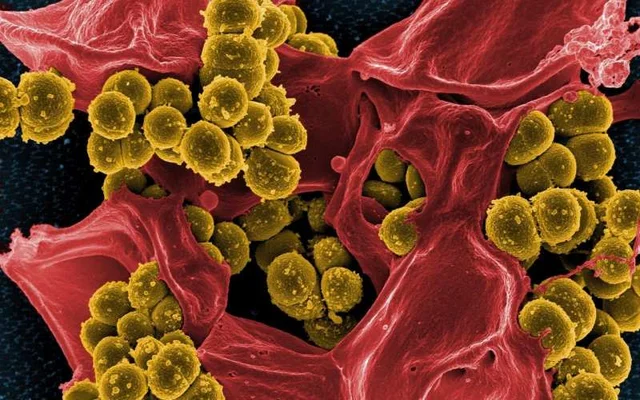4:07 PM Scientists discover a strategy of the conspiracy of multi-drug resistant microbes | |
Scientists from the Institute of tübingen and the German center for the study of infections (DZIF) have achieved a breakthrough in decoding multi-resistant pathogens. The team led by Dr. Andreas Peschel and Dr. Thilo stele managed to decipher the structure and functions of a previously unknown protein used by terrible pathogens, such as Staphylococcus aureus, as a magical cloak, in order to defend themselves from the human immune system. The study was posted in Nature on Wednesday. Infections caused by microbes such as Staphylococcus aureus hinder a large number of deaths worldwide. Strains of Staphylococcus aureus resistant to antibiotic methicillin (abbreviated MRSA), the more afraid in clinics. According to a study posted in early November, only in 2015 alone in the EU there were 670,000 diseases caused by multi-resistant pathogens and 33,000 patients died. As a rule, our immune system copes with pathogenic microbes, such as bacteria or microbes. However, at times, the protective strategies of the human body will not work, especially in immunocompromised patients. The bulk of drugs at the same time ineffective against resistant pathogens. Effective substitution drugs and protective vaccines opposite MRSA yet to be seen. As a consequence, a clear awareness of protective devices has the ability to lead to fresh ways of healing microbes. Scientists from the tübingen Institute told how MRSA bacteria are made invisible to the immune system. They were able to demonstrate, in fact almost all of the more frequent germs MRSA bought previously obscure protein that predosteregaet detection of pathogens by antibodies. Tübingen scientists have given the protein the title tarpaulin (abbreviated from teichoic acid ribitol P). "The tarp still mysteriously changes the structure of molecules of carbohydrates on the surface of a pathogen," explained Dr. Andreas Peschel of the research Institution of Microbiology and infectious medicine of Tubingen Institute. "As a result, the immune system is not able to produce antibodies against the more significant MRSA RH factor, teichoic acids," said Peshel. "The immune system is 'blinded' and loses its key weapon against the pathogen." Reprogrammed by phages Scientists from Tubingen hope, in fact, that bacterial camouflage is considered the result of the exchange between pathogens and their natural enemies, popular as bacteriophages. Phages are a class of microbes that storm bacteria, use them as host cells, and feed on them. In this case, phages, similarly, reprogrammed its own owner with the support of tarpaulin protein and, thus, corrected the plane of the bacterium. The 1st creators of the study, David Gerlach and Yinglan Guo, succeeded in elucidating the mechanism and structure of tarp. "Now we have a precise awareness of how protein acts as an enzyme at the molecular level," said Gerlach. The structural and functional test of tarpaulin is considered to be a wonderful soil for the development of fresh substances that block the tarpaulin, allowing the immune system to detect pathogenic tiny organisms. The interdisciplinary alignment with the role of researchers from Denmark, Germany, England, Italy, the Netherlands and South Korea made all the more significant sense for the furor of this work. "The invention of the tarpaulin came as an absolute surprise to us. This explains quite well why the immune system often does not have a chance in front of MRSA," said Dr. Thilo stele of the interdepartmental University of biochemistry. "The results will undoubtedly help us to create the best ways of healing and vaccines against pathogens. Pascal referred to not so long ago approved by the tübingen cluster of modern skill " control of bacteria to combat infections "and close cooperation with the German centre of infectious studies:" these outstanding network will undoubtedly help us in the promotion subsequent studies of MRSA and TarP." | |
|
| |
| Total comments: 0 | |
